Drivers of Antibiotic Use in Semi-Intensive Poultry Farms: Evidence from a Survey in Senegal
Abstract
1. Introduction
- Whether better biosecurity, vaccination, and awareness of AMR lead to lower or more selective use of antibiotics (e.g., limiting use to therapeutic use, or avoiding use of antibiotics intended for use in humans) in poultry farms.
- What effect these three factors, as well as antibiotic use (defined by expenditure on antibiotics), have on farm profitability and disease incidence.
2. Results
2.1. Descriptive Statistics
2.2. Main Results
2.3. Robustness
3. Discussion
3.1. Overview of Findings
3.2. Comparison with Previous Work
3.3. Meaning of Results and Implications for Future Research
3.4. Limitations
4. Materials and Methods
4.1. Study Aims, Data Collection Methods, and Setting
4.2. Variables Used
4.3. Main Statistical Methods
4.4. Robustness and Further Specifications
5. Conclusions
Author Contributions
Funding
Institutional Review Board Statement
Informed Consent Statement
Data Availability Statement
Acknowledgments
Conflicts of Interest
Appendix A. Full Set of Survey Questions Used
Appendix B. Univariate Specifications
| Dependent Variable | ||||||
| “AMU quantity” | “AMU in healthy birds” | |||||
| OLS | logistic | |||||
| (1) | (2) | (3) | (4) | (5) | (6) | |
| vaccination | 4.787 | −0.099 | ||||
| (6.036) | (0.265) | |||||
| biosecurity | −14.279 | −2.904 ** | ||||
| (32.062) | (1.323) | |||||
| “AMR attitudes” | −10.015 | −0.921 * | ||||
| (12.978) | (0.501) | |||||
| Constant | 22.955 ** | 40.783 * | 36.558 *** | 0.420 | 2.125 ** | 0.681 ** |
| (11.448) | (20.914) | (7.314) | (0.507) | (0.873) | (0.279) | |
| Observations | 134 | 134 | 134 | 220 | 220 | 220 |
| R2 | 0.005 | 0.002 | 0.004 | |||
| Adjusted R2 | −0.003 | −0.006 | −0.003 | |||
| Log Likelihood | −150.882 | −148.460 | −149.247 | |||
| Akaike Inf. Crit. | 305.764 | 300.920 | 302.494 | |||
| Residual Std. Error (df = 132) | 40.471 | 40.537 | 40.476 | |||
| F Statistic (df = 1; 132) | 0.629 | 0.198 | 0.595 | |||
| Note: * p < 0.1; ** p < 0.05; *** p < 0.01. | ||||||
| Dependent Variable | ||||||
| “broiler productivity” | “layer productivity” | |||||
| (1) | (2) | (3) | (4) | (5) | (6) | |
| vaccination | 3.968 * | 0.007 | ||||
| (2.063) | (0.285) | |||||
| biosecurity | 29.245 *** | −0.002 | ||||
| (11.110) | (1.204) | |||||
| “AMR attitudes” | 4.461 | −0.088 | ||||
| (4.614) | (0.301) | |||||
| Constant | 12.400 *** | 1.431 | 17.436 *** | 0.869 | 0.883 | 0.925 *** |
| (3.893) | (6.974) | (2.476) | (0.560) | (0.798) | (0.172) | |
| Observations | 121 | 121 | 121 | 50 | 50 | 50 |
| R2 | 0.030 | 0.055 | 0.008 | 0.00001 | 0.00000 | 0.002 |
| Adjusted R2 | 0.022 | 0.047 | −0.001 | −0.021 | −0.021 | −0.019 |
| Residual Std. Error | 13.342 (df = 119) | 13.170 (df = 119) | 13.495 (df = 119) | 0.625 (df = 48) | 0.625 (df = 48) | 0.625 (df = 48) |
| F Statistic | 3.700 * (df = 1; 119) | 6.929 *** (df = 1; 119) | 0.935 (df = 1; 119) | 0.001 (df = 1; 48) | 0.00000 (df = 1; 48) | 0.086 (df = 1; 48) |
| Note: * p < 0.1; ** p < 0.05; *** p < 0.01. | ||||||
| Dependent Variable | |||
| “disease incidence” | |||
| (1) | (2) | (3) | |
| vaccination | 0.477 * | ||
| (0.265) | |||
| biosecurity | −0.053 | ||
| (1.306) | |||
| “AMR attitudes” | −0.473 | ||
| (0.506) | |||
| Constant | 1.218 ** | 2.130 ** | 2.322 *** |
| (0.506) | (0.857) | (0.279) | |
| Observations | 220 | 220 | 220 |
| R2 | 0.015 | 0.00001 | 0.004 |
| Adjusted R2 | 0.010 | −0.005 | −0.001 |
| Residual Std. Error (df = 218) | 2.040 | 2.055 | 2.051 |
| F Statistic (df = 1; 218) | 3.247 * | 0.002 | 0.874 |
| Note: * p < 0.1; ** p < 0.05; *** p < 0.01. | |||
Appendix C. Specifications with interactions between Our Main Covariates
| Dependent Variable | |||
| broiler_productivity | layer_productivity | disease_incidence | |
| (1) | (2) | (3) | |
| biosecurity | 23.886 | −0.503 | −3.642 |
| (29.515) | (0.694) | (2.925) | |
| AMU_quantity | 0.103 | −0.003 | −0.071 |
| (0.581) | (0.008) | (0.051) | |
| vaccination | 0.851 | −0.088 | 0.499 |
| (2.594) | (0.068) | (0.342) | |
| AMR_attitudes | 2.316 | −0.087 | −1.104 |
| (6.517) | (0.099) | (0.751) | |
| farm_size | 0.004 *** | 0.00000 | 0.00001 |
| (0.001) | (0.00001) | (0.0001) | |
| other_species_on_farm | 2.383 | 0.109 | −0.226 |
| (4.228) | (0.074) | (0.541) | |
| portion_broilers | −0.589 | ||
| (0.423) | |||
| biosecurity:AMU_quantity | 0.028 | 0.004 | 0.132 |
| (0.942) | (0.012) | (0.081) | |
| Constant | −4.812 | 1.273 ** | 4.109 ** |
| (17.415) | (0.502) | (1.877) | |
| Observations | 84 | 26 | 134 |
| R2 | 0.251 | 0.272 | 0.117 |
| Adjusted R2 | 0.182 | −0.011 | 0.060 |
| Residual Std. Error | 13.580 (df = 76) | 0.114 (df = 18) | 2.165 (df = 125) |
| F Statistic | 3.631 *** (df = 7; 76) | 0.961 (df = 7; 18) | 2.063 ** (df = 8; 125) |
| Note: ** p < 0.05; *** p < 0.01. | |||
| Dependent Variable | |||
| broiler_productivity | layer_productivity | disease_incidence | |
| (1) | (2) | (3) | |
| biosecurity | 11.585 | 1.719 | −7.787 |
| (48.671) | (16.414) | (5.130) | |
| vaccination | −1.174 | 0.129 | −1.433 |
| (13.490) | (6.424) | (1.513) | |
| AMR_attitudes | 0.773 | −0.077 | −0.497 |
| (4.798) | (0.247) | (0.521) | |
| farm_size | 0.001 | −0.00001 | 0.00000 |
| (0.001) | (0.00001) | (0.00004) | |
| other_species_on_farm | 2.310 | −0.075 | 0.383 |
| (3.445) | (0.215) | (0.406) | |
| portion_broilers | −0.771 ** | ||
| (0.301) | |||
| biosecurity:vaccination | 6.352 | −0.148 | 3.406 |
| (24.938) | (8.130) | (2.614) | |
| Constant | 5.433 | −0.273 | 6.284 ** |
| (25.821) | (12.924) | (2.930) | |
| Observations | 120 | 49 | 220 |
| R2 | 0.086 | 0.046 | 0.062 |
| Adjusted R2 | 0.037 | −0.091 | 0.031 |
| Residual Std. Error | 13.248 (df = 113) | 0.473 (df = 42) | 2.018 (df = 212) |
| F Statistic | 1.770 (df = 6; 113) | 0.335 (df = 6; 42) | 2.012 * (df = 7; 212) |
| Note: * p < 0.1; ** p < 0.05. | |||
| Dependent Variable | |||
| broiler_productivity | layer_productivity | disease_incidence | |
| (1) | (2) | (3) | |
| AMR_attitudes | −1.069 | −0.180 | 0.060 |
| (11.518) | (0.127) | (1.059) | |
| AMU_quantity | −0.071 | −0.001 | 0.025 * |
| (0.233) | (0.001) | (0.014) | |
| farm_size | 0.005 *** | 0.00000 | −0.00002 |
| (0.001) | (0.00000) | (0.0001) | |
| other_species_on_farm | 3.451 | 0.096 | −0.163 |
| (4.180) | (0.070) | (0.542) | |
| portion_broilers | −0.520 | ||
| (0.425) | |||
| AMR_attitudes:AMU_quantity | 0.362 | 0.002 | −0.030 |
| (0.423) | (0.002) | (0.028) | |
| Constant | 12.802 * | 0.832 *** | 2.154 *** |
| (6.853) | (0.077) | (0.711) | |
| Observations | 84 | 26 | 134 |
| R2 | 0.227 | 0.222 | 0.090 |
| Adjusted R2 | 0.178 | 0.027 | 0.047 |
| Residual Std. Error | 13.613 (df = 78) | 0.112 (df = 20) | 2.180 (df = 127) |
| F Statistic | 4.586 *** (df = 5; 78) | 1.138 (df = 5; 20) | 2.092 * (df = 6; 127) |
| Note: * p < 0.1; ** p < 0.05; *** p < 0.01. | |||
Appendix D. Ethical and Scientific Approval for Original Data Collection


Appendix E. Copy of the Informed Consent Form (Translated into English)

Appendix F. Correlations between Key Variables (Pearson’s Correlation Coefficient)
Appendix F.1. The Whole Sample
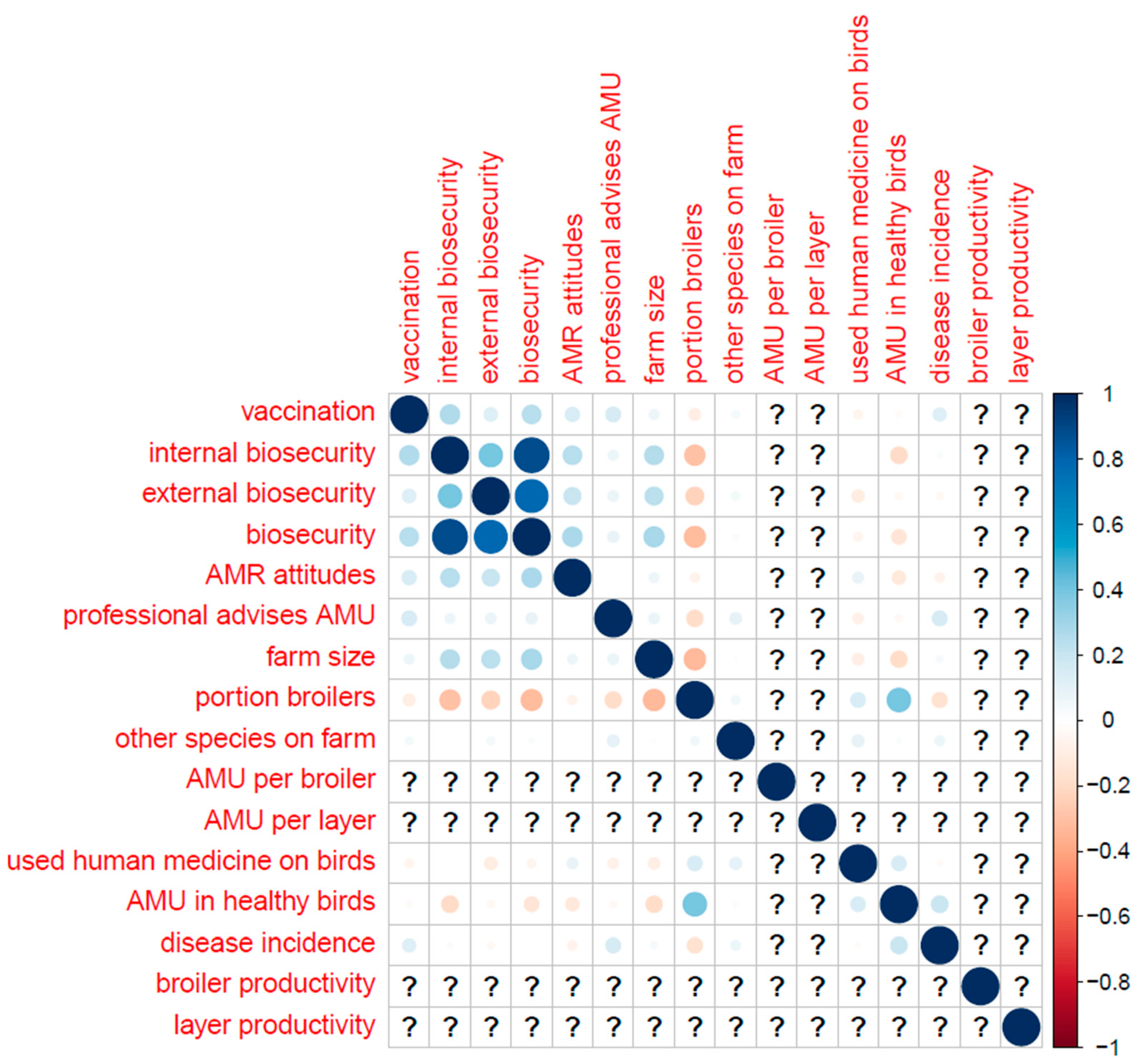
Appendix F.2. Broilers only
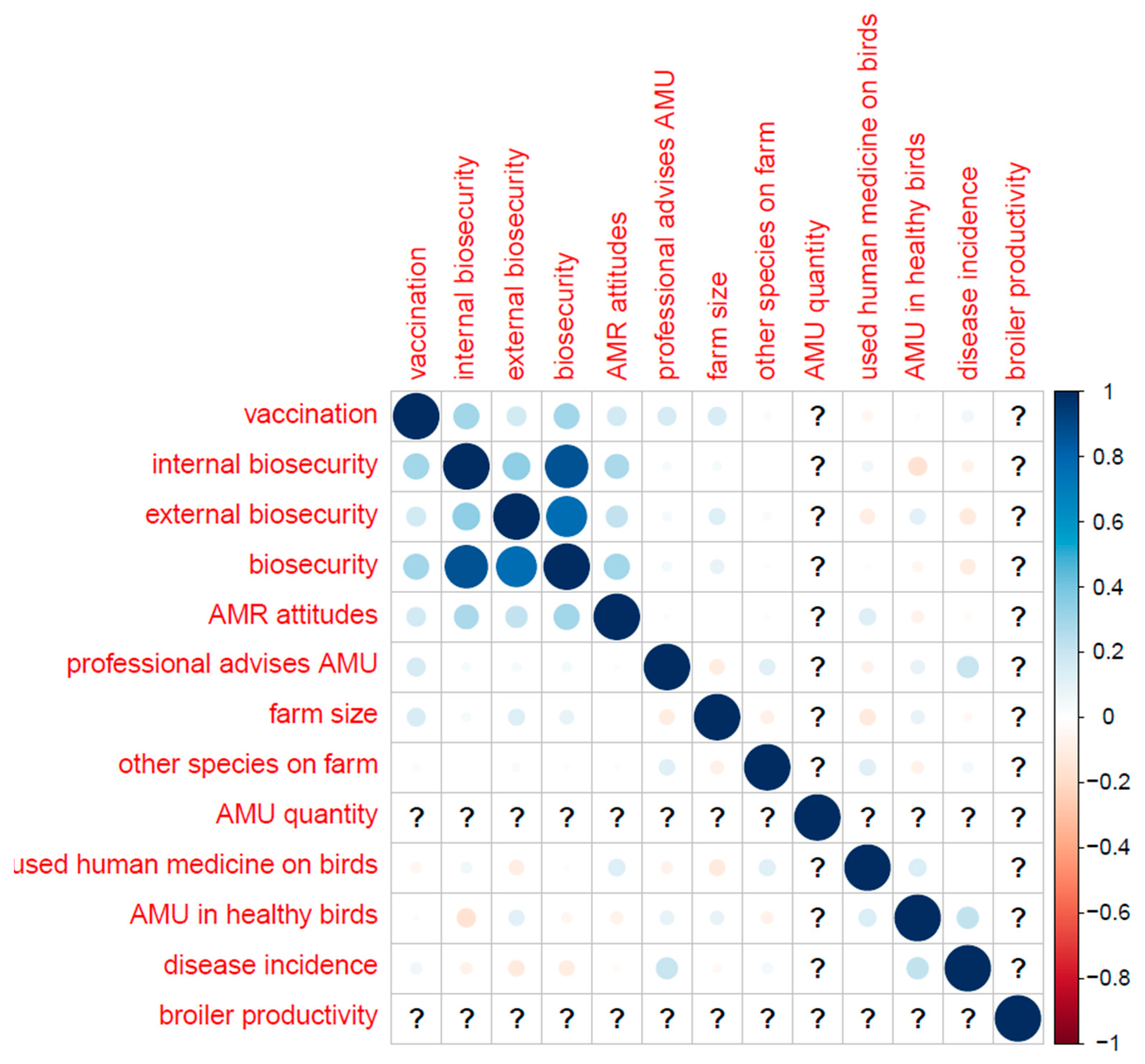
Appendix F.3. Layers only
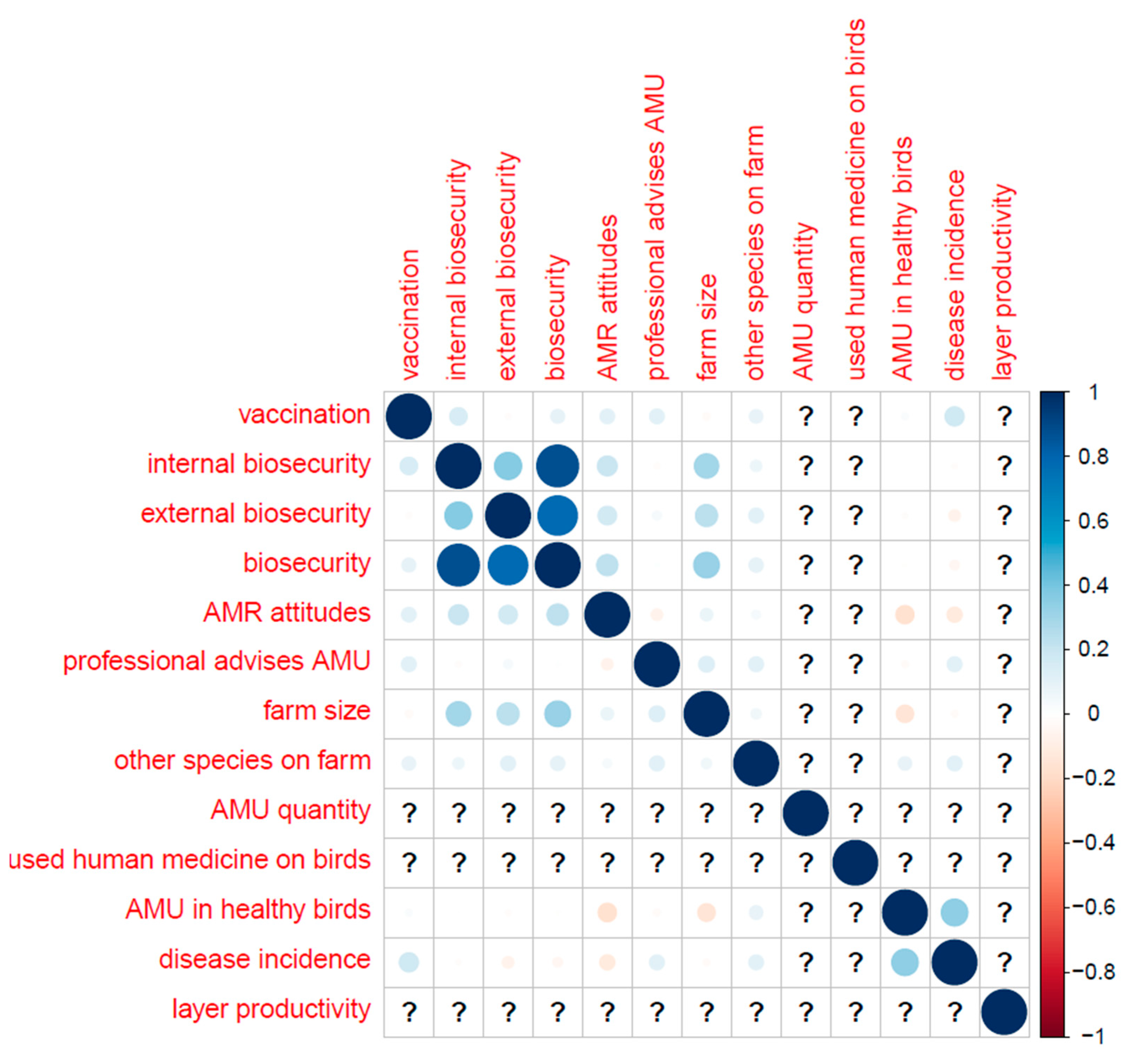
Appendix G. Effect of Professional Advice on AMU Patterns
| Dependent Variable | ||||
| “AMU quantity” | “AMU in healthy birds” | |||
| OLS | logistic | |||
| (1) | (2) | (3) | (4) | |
| “professional advises AMU” | 6.673 | 4.634 | 0.277 | 0.244 |
| (10.034) | (10.404) | (0.414) | (0.422) | |
| vaccination | 4.933 | 0.112 | ||
| (6.423) | (0.303) | |||
| biosecurity | −11.088 | 0.176 | ||
| (36.905) | (1.604) | |||
| “AMR attitudes” | −8.507 | −0.884 | ||
| (13.855) | (0.566) | |||
| “farm size” | −0.003 ** | −0.003 ** | −0.00005 | −0.00005 |
| (0.001) | (0.001) | (0.0001) | (0.0001) | |
| “other species on farm” | −4.559 | −4.745 | −0.018 | −0.021 |
| (9.994) | (10.112) | (0.446) | (0.450) | |
| “portion broilers” | −17.031 ** | −17.423 ** | 1.642 *** | 1.656 *** |
| (7.620) | (7.793) | (0.321) | (0.334) | |
| Constant | 42.455 *** | 46.570 * | −0.763 | −0.643 |
| (11.506) | (24.733) | (0.465) | (1.138) | |
| Observations | 134 | 134 | 220 | 220 |
| R2 | 0.071 | 0.078 | ||
| Adjusted R2 | 0.042 | 0.026 | ||
| Log Likelihood | −132.447 | −131.163 | ||
| Akaike Inf. Crit. | 274.895 | 278.326 | ||
| Residual Std. Error | 39.560 (df = 129) | 39.877 (df = 126) | ||
| F Statistic | 2.453 ** (df = 4; 129) | 1.516 (df = 7; 126) | ||
| Note: * p < 0.1; ** p < 0.05; *** p < 0.01. | ||||
References
- OECD. Stemming the Superbug Tide: Just A Few Dollars More OECD; 2018 (OECD Health Policy Studies). Available online: https://www.oecd-ilibrary.org/social-issues-migration-health/stemming-the-superbug-tide_9789264307599-en (accessed on 9 March 2022).
- Van Boeckel, T.P.; Brower, C.; Gilbert, M.; Grenfell, B.T.; Levin, S.A.; Robinson, T.P.; Teillant, A.; Laxminarayan, R. Global trends in antimicrobial use in food animals. Proc. Natl. Acad. Sci. USA 2015, 112, 5649–5654. [Google Scholar] [CrossRef] [PubMed]
- Bennani, H.; Mateus, A.; Mays, N.; Eastmure, E.; Stärk, K.D.C.; Häsler, B. Overview of Evidence of Antimicrobial Use and Antimicrobial Resistance in the Food Chain. Antibiot 2020, 28, 49. [Google Scholar] [CrossRef] [PubMed]
- Woolhouse, M.; Ward, M.; Bunnik, B.; Farrar, J. Antimicrobial Resistance in Humans, Livestock and the Wider Environment. Philos. Trans. R Soc. 2015, 370, 20140083. [Google Scholar] [CrossRef]
- Landers, T.; Cohen, B.; Wittum, T.; Larson, E.; Faan, C. A Review of Antibiotic Use in Food Animals: Perspective, Policy, and Potential. Public Health Rep. 2012, 127, 4–22. [Google Scholar] [CrossRef] [PubMed]
- Cuong, N.V.; Padungtod, P.; Thwaites, G.; Carrique-Mas, J.J. Antimicrobial Usage in Animal Production: A Review of the Literature with a Focus on Low-and Middle-Income Countries. Antibiotics 2018, 7, 75. [Google Scholar] [CrossRef] [PubMed]
- Who We Are|Antimicrobial Resistance|Food and Agriculture Organization of the United Nations. Available online: https://www.fao.org/antimicrobial-resistance/quadripartite/who-we-are/en/ (accessed on 28 November 2022).
- Target. Global Database for Tracking Antimicrobial Resistance (AMR) Country Self-Assessment Survey (TrACSS). Available online: http://amrcountryprogress.org/ (accessed on 28 November 2022).
- Broom, L.J. The sub-inhibitory theory for antibiotic growth promoters. Poult. Sci. 2017, 96, 3104–3108. [Google Scholar] [CrossRef] [PubMed]
- Vounba, P.; Arsenault, J.; Bada-Alambédji, R.; Fairbrother, J.M. Prevalence of antimicrobial resistance and potential pathogenicity, and possible spread of third generation cephalosporin resistance, in Escherichia coli isolated from healthy chicken farms in the region of Dakar, Senegal. PLoS ONE 2019, 14, e0214304. [Google Scholar] [CrossRef] [PubMed]
- Dione, M.M.; Geerts, S.; Antonio, M. Characterisation of novel strains of multiply antibiotic-resistant Salmonella recovered from poultry in Southern Senegal. J. Infect Dev. Ctries. 2012, 6, 436–442. [Google Scholar] [CrossRef] [PubMed]
- World Bank Group. Pulling Together to Beat Superbugs; International Bank for Reconstruction and Development/World Bank: Washington, DC, USA, 2019. [Google Scholar]
- Emes, E.T.; Dang-Xuan, S.; Le, T.T.H.; Waage, J.; Knight, G.; Naylor, N. Cross-Sectoral Cost-Effectiveness of Interventions to Control Antimicrobial Resistance in Livestock Production; Social Science Research Network: Rochester, NY, USA, 2022; p. 4104382. Available online: https://papers.ssrn.com/abstract=4104382 (accessed on 10 January 2023).
- Chaiban, C.; Robinson, T.P.; Fèvre, E.M.; Ogola, J.; Akoko, J.; Gilbert, M.; Vanwambeke, S.O. Early intensification of backyard poultry systems in the tropics: A case study. Anim. Int. J. Anim. Biosci. 2020, 14, 11. [Google Scholar] [CrossRef] [PubMed]
- Parkhi, C.M.; Liverpool-Tasie, L.S.O.; Reardon, T. Do Smaller Chicken Farms Use More Antibiotics? Evidence of Antibiotic Diffusion from Nigeria. Agribusiness. Available online: https://onlinelibrary.wiley.com/doi/abs/10.1002/agr.21770 (accessed on 16 November 2022).
- Masud, A.A.; Rousham, E.K.; Islam, M.A.; Alam, M.U.; Rahman, M.; Mamun, A.A.; Sarker, S.; Asaduzzaman, M.; Unicomb, L. Drivers of Antibiotic Use in Poultry Production in Bangladesh: Dependencies and Dynamics of a Patron-Client Relationship. Front. Vet. Sci. 2020, 7, 78. Available online: https://www.frontiersin.org/articles/10.3389/fvets.2020.00078 (accessed on 10 January 2023). [CrossRef] [PubMed]
- Xu, J.; Sangthong, R.; McNeil, E.; Tang, R.; Chongsuvivatwong, V. Antibiotic use in chicken farms in northwestern China. Antimicrob Resist Infect. Control. 2020, 9, 10. [Google Scholar] [CrossRef] [PubMed]
- AMUSE Livestock, Version 2―Antimicrobial Use in Livestock Production: A Tool to Harmonise Data Collection on Knowledge, Attitude and Practices [In-ternet]. CGIAR Research Program on Livestock. 2020. Available online: https://livestock.cgiar.org/publication/amuse-livestock-version-2%E2%80%95antimicrobial-use-livestock-production-tool-harmonise-data (accessed on 28 October 2022).
- Heckman, J.J. The Common Structure of Statistical Models of Truncation, Sample Selection and Limited Dependent Variables and a Simple Estimator for Such Models. In Annals of Economic and Social Measurement; NBER: Cambridge, MA, USA, 1976; Volume 5, number 4; pp. 475–492. Available online: https://www.nber.org/books-and-chapters/annals-economic-and-social-measurement-volume-5-number-4/common-structure-statistical-models-truncation-sample-selection-and-limited-dependent-variables-and (accessed on 23 February 2023).
- Hennessey, M.; Fournié, G.; Hoque, M.A.; Biswas, P.K.; Alarcon, P.; Ebata, A.; Mahmud, R.; Hasan, M.; Barnett, T. Intensification of fragility: Poultry production and distribution in Bangladesh and its implications for disease risk. Prev. Vet. Med. 2021, 191, 105367. [Google Scholar] [CrossRef] [PubMed]
- Marangon, S.; Busani, L. The use of vaccination in poultry production. Rev. Sci. Tech. Int. Off Epizoot. 2007, 26, 265–274. [Google Scholar] [CrossRef]
- Aboah, J.; Enahoro, D. A systems thinking approach to understand the drivers of change in backyard poultry farming system. Agric. Syst. 2022, 202, 103475. [Google Scholar] [CrossRef]
- STROBE. Available online: https://www.strobe-statement.org/ (accessed on 13 July 2022).
- R Core Team. R: A language and environment for statistical computing. Vienna, Austria: R Foundation for Statistical Computing. Available online: https://www.R-project.org/ (accessed on 23 February 2023).
- R Studio Team. RStudio: Integrated Development for R. Boston, USA: R Studio. Available online: http://www.rstudio.com/ (accessed on 23 February 2023).
- Hlavac, M. Stargazer: Beautiful LATEX, HTML and ASCII Tables from R Statistical Output: 11. 2022. Available online: https://cran.irsn.fr/web/packages/stargazer/vignettes/stargazer.pdf (accessed on 23 February 2023).
- Wickham, H.; R Studio. Tidyverse: Easily Install and Load the ‘Tidyverse’. 2021. Available online: https://CRAN.R-project.org/package=tidyverse (accessed on 22 April 2022).
- Wickham, H.; Hester, J.; Francois, R.; Bryan, J.; Bearrows, S.; Jylänki, J.; Jørgensen, M. Ggplot2: Create Elegant Data Visualisations Using the Grammar of Graphics. 2021. Available online: https://CRAN.R-project.org/package=ggplot2 (accessed on 22 April 2022).
- Taiyun Wei Simko, V. Corrplot Package. 2021. Available online: https://cran.r-project.org/web/packages/corrplot/vignettes/corrplot-intro.html (accessed on 23 February 2023).
- Wickham, H.; Roman, F.; Henry, L.; Müller, K.; R Studio. Dplyr: A Grammar of Data Manipulation. 2022. Available online: https://cran.r-project.org/web/packages/dplyr/index.html (accessed on 23 February 2023).
- Bonferroni, C.E. Teoria statistica delle classi e calcolo delle probabilità. Seeber 1936, 62. [Google Scholar]
- Benjamini, Y.; Hochberg, Y. Controlling the False Discovery Rate: A Practical and Powerful Approach to Multiple Testing. J. R Stat. Soc. Ser. B Methodol. 1995, 57, 289–300. [Google Scholar] [CrossRef]
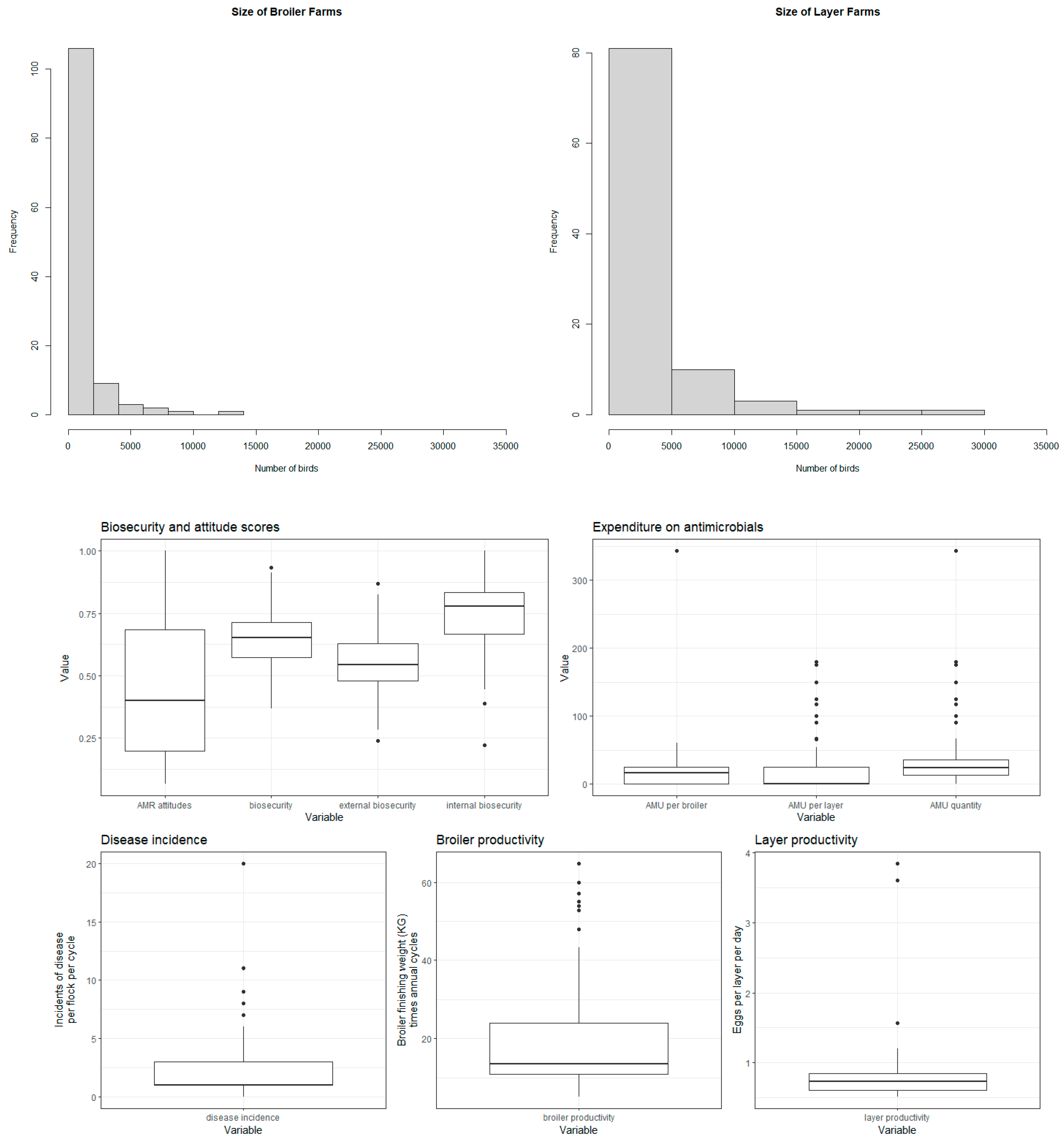
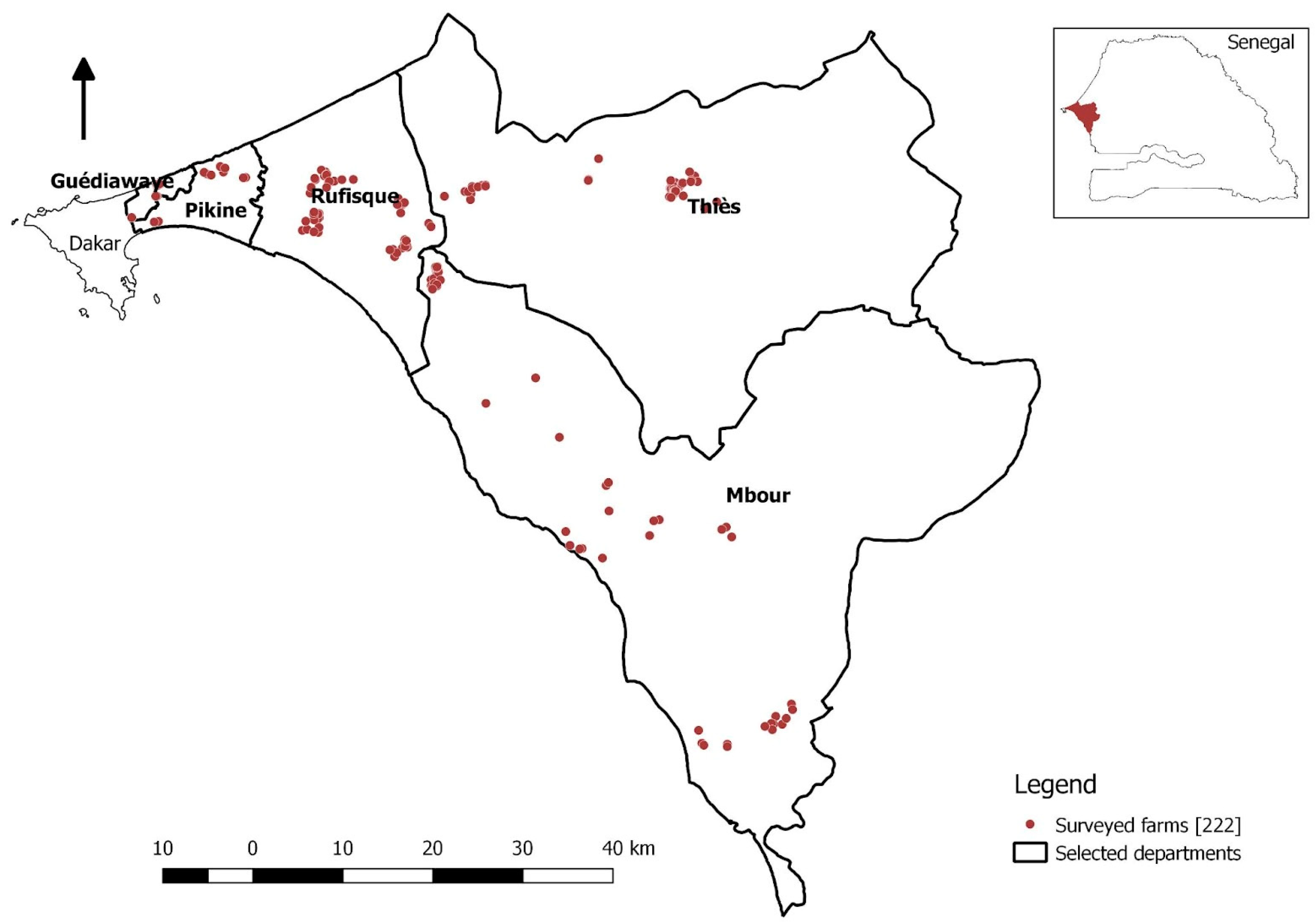
| Variable | Description |
|---|---|
| “Vaccination” | no protocol (15/222) protocol in place but not always adhered to (6/222) protocol in place and always adhered to (201/222) |
| “Other species on farm” | no species present other than chickens (193/222) other species present (29/222) |
| “AMU in healthy birds” | did not use antibiotics in healthy birds (216/222) used antibiotics in healthy birds (6/222) |
| “Portion broilers” | Broilers only: 124/222 Layers only: 97/222 53% broilers and 47% layers: 1/222 |
| Dependent Variable | ||||
|---|---|---|---|---|
| “AMU quantity” | ||||
| (1) | (2) | (3) | (4) | |
| vaccination | 4.130 | 5.545 | ||
| (5.925) | (6.254) | |||
| biosecurity | −10.110 | −10.815 | ||
| (33.572) | (36.783) | |||
| “AMR attitudes” | −8.173 | −9.224 | ||
| (12.762) | (13.718) | |||
| “farm size” | −0.003 ** | −0.003 ** | −0.003 ** | −0.003 ** |
| (0.001) | (0.001) | (0.001) | (0.001) | |
| “other species on farm” | −3.767 | −3.100 | −3.585 | −3.981 |
| (9.838) | (9.860) | (9.829) | (9.934) | |
| “portion broilers” | −17.822 ** | −18.575 ** | −18.197 ** | −18.156 ** |
| (7.439) | (7.552) | (7.424) | (7.593) | |
| Constant | 41.024 *** | 55.206 ** | 52.623 *** | 49.912 ** |
| (12.857) | (22.799) | (9.176) | (23.493) | |
| Observations | 134 | 134 | 134 | 134 |
| R2 | 0.071 | 0.068 | 0.070 | 0.076 |
| Adjusted R2 | 0.042 | 0.039 | 0.042 | 0.033 |
| Residual Std. Error | 39.553 (df = 129) | 39.614 (df = 129) | 39.565 (df = 129) | 39.751 (df = 127) |
| F Statistic | 2.464 ** (df = 4; 129) | 2.358 * (df = 4; 129) | 2.444 ** (df = 4; 129) | 1.746 (df = 6; 127) |
| Dependent Variable | ||||
|---|---|---|---|---|
| “AMU in healthy birds” | ||||
| (1) | (2) | (3) | (4) | |
| vaccination | 0.077 | 0.137 | ||
| (0.290) | (0.300) | |||
| biosecurity | −0.326 | 0.163 | ||
| (1.520) | (1.602) | |||
| “AMR attitudes” | −0.846 | −0.896 | ||
| (0.543) | (0.565) | |||
| “farm size” | −0.00005 | −0.00005 | −0.00004 | −0.00005 |
| (0.0001) | (0.0001) | (0.0001) | (0.0001) | |
| “other species on farm” | 0.009 | 0.019 | 0.017 | 0.005 |
| (0.443) | (0.443) | (0.446) | (0.447) | |
| “portion broilers” | 1.606 *** | 1.582 *** | 1.600 *** | 1.621 *** |
| (0.314) | (0.322) | (0.315) | (0.327) | |
| Constant | −0.655 | −0.298 | −0.117 | −0.456 |
| (0.606) | (1.039) | (0.372) | (1.089) | |
| Observations | 220 | 220 | 220 | 220 |
| Log Likelihood | −132.635 | −132.647 | −131.451 | −131.329 |
| Akaike Inf. Crit. | 275.271 | 275.294 | 272.902 | 276.659 |
| Dependent Variable | ||||
|---|---|---|---|---|
| “disease incidence” | ||||
| (1) | (2) | (3) | (4) | |
| vaccination | 0.409 | 0.515 | ||
| (0.327) | (0.344) | |||
| biosecurity | −0.251 | −0.199 | ||
| (1.858) | (2.016) | |||
| “AMR attitudes” | −0.794 | −1.000 | ||
| (0.705) | (0.753) | |||
| “AMU quantity” | 0.011 ** | 0.012 ** | 0.012 ** | 0.011 ** |
| (0.005) | (0.005) | (0.005) | (0.005) | |
| “farm size” | −0.00003 | −0.00003 | −0.00002 | −0.00002 |
| (0.0001) | (0.0001) | (0.0001) | (0.0001) | |
| “other species on farm” | −0.167 | −0.116 | −0.148 | −0.208 |
| (0.542) | (0.546) | (0.542) | (0.545) | |
| “portion broilers” | −0.564 | −0.603 | −0.600 | −0.575 |
| (0.419) | (0.427) | (0.419) | (0.425) | |
| Constant | 1.481 ** | 2.381 * | 2.618 *** | 1.923 |
| (0.736) | (1.290) | (0.567) | (1.310) | |
| Observations | 134 | 134 | 134 | 134 |
| R2 | 0.084 | 0.073 | 0.082 | 0.098 |
| Adjusted R2 | 0.048 | 0.036 | 0.046 | 0.048 |
| Residual Std. Error | 2.179 (df = 128) | 2.192 (df = 128) | 2.181 (df = 128) | 2.178 (df = 126) |
| F Statistic | 2.337 ** (df = 5; 128) | 2.004 * (df = 5; 128) | 2.274 * (df = 5; 128) | 1.959 * (df = 7; 126) |
| Dependent Variable | ||||
|---|---|---|---|---|
| “broiler productivity” | ||||
| (1) | (2) | (3) | (4) | |
| vaccination | 2.477 | 0.847 | ||
| (2.450) | (2.573) | |||
| biosecurity | 28.393 ** | 24.638 | ||
| (13.198) | (15.179) | |||
| “AMR attitudes” | 7.423 | 2.330 | ||
| (5.815) | (6.458) | |||
| “AMU quantity” | 0.121 *** | 0.121 *** | 0.126 *** | 0.120 *** |
| (0.041) | (0.040) | (0.040) | (0.040) | |
| “farm size” | 0.004 *** | 0.004 *** | 0.005 *** | 0.004 *** |
| (0.001) | (0.001) | (0.001) | (0.001) | |
| “other species on farm” | 2.364 | 2.174 | 3.491 | 2.388 |
| (4.151) | (4.056) | (4.173) | (4.196) | |
| Constant | 8.087 * | −4.919 | 8.048 ** | −5.264 |
| (4.628) | (8.247) | (3.995) | (8.484) | |
| Observations | 84 | 84 | 84 | 84 |
| R2 | 0.214 | 0.248 | 0.220 | 0.251 |
| Adjusted R2 | 0.174 | 0.210 | 0.180 | 0.192 |
| Residual Std. Error | 13.641 (df = 79) | 13.344 (df = 79) | 13.590 (df = 79) | 13.492 (df = 77) |
| F Statistic | 5.378 *** (df = 4; 79) | 6.511 *** (df = 4; 79) | 5.569 *** (df = 4; 79) | 4.292 *** (df = 6; 77) |
| Dependent Variable | ||||
|---|---|---|---|---|
| “layer productivity” | ||||
| (1) | (2) | (3) | (4) | |
| vaccination | −0.072 | −0.082 | ||
| (0.062) | (0.064) | |||
| biosecurity | −0.357 | −0.335 | ||
| (0.417) | (0.460) | |||
| “AMR attitudes” | −0.106 | −0.076 | ||
| (0.084) | (0.092) | |||
| “AMU quantity” | −0.001 | −0.001 | −0.001 | −0.001 |
| (0.001) | (0.001) | (0.001) | (0.001) | |
| “farm size” | −0.00000 | 0.00000 | −0.00000 | 0.00000 |
| (0.00000) | (0.00001) | (0.00000) | (0.00001) | |
| “other species on farm” | 0.115 | 0.119 | 0.096 | 0.112 |
| (0.069) | (0.071) | (0.070) | (0.072) | |
| Constant | 0.876 *** | 0.956 *** | 0.797 *** | 1.149 *** |
| (0.127) | (0.263) | (0.062) | (0.326) | |
| Observations | 26 | 26 | 26 | 26 |
| R2 | 0.189 | 0.166 | 0.198 | 0.268 |
| Adjusted R2 | 0.035 | 0.007 | 0.045 | 0.036 |
| Residual Std. Error | 0.112 (df = 21) | 0.113 (df = 21) | 0.111 (df = 21) | 0.112 (df = 19) |
| F Statistic | 1.226 (df = 4; 21) | 1.043 (df = 4; 21) | 1.295 (df = 4; 21) | 1.157 (df = 6; 19) |
| Varname | Meaning | Units |
|---|---|---|
| “Vaccination” | A score for having (and adhering to) a vaccination protocol for birds | 0 = no protocol 1 = protocol in place but not always adhered to 2 = protocol in place and always adhered to |
| “Internal biosecurity” | A score for internal biosecurity measures on the farm, based on categorical responses to several questions about biosecurity procedures. As with other scores in this dataset, each question about internal biosecurity gave a number of points (1 for the ‘best’ answer and 0 for the ‘worst’ answer, with fractions for answers in between). The internal biosecurity score is then calculated as the mean of the scores attained on all questions about internal biosecurity | Continuous, ranging between 0 (met none of the standards) and 1 (met every standard) |
| “External biosecurity” | A score for external biosecurity measures on the farm, based on categorical responses to several questions about biosecurity procedures | Continuous, ranging between 0 (met none of the standards) and 1 (met every standard) |
| “Biosecurity” | The mean of the internal and external biosecurity scores | Continuous, ranging between 0 (met none of the standards) and 1 (met every standard) |
| “AMR attitudes” | A score for attitudes about antimicrobial resistance and stewardship, based on categorical responses to several questions | Continuous, ranging between 0 (met none of the standards) and 1 (met every standard) |
| “Farm size” | The number of chickens on the farm | Chickens |
| “Other species on farm” | The presence of animal species other than chickens on the farm | Binary 0 = no other species present 1 = other species present |
| “AMU quantity” | The quantity of antibiotics used in chicken production. “AMU per broiler” and “AMU per layer” disaggregate this figure by production type | FCFA (Franc de la Communauté Financière Africaine, or West African Franc) spent on antibiotics per bird per production cycle |
| “AMU in healthy birds” | The use of antibiotics in healthy birds (for whatever reason) | Binary 0 = did not use antibiotics in healthy birds 1 = used antibiotics in healthy birds |
| “Disease incidence” | Amount of disease occurring in the flock | Number of individual disease incidents recorded in the flock during a production cycle |
| “Broiler productivity” | Productivity of broilers | Average finishing weight of a broiler, multiplied by the number of production cycles per year |
| “Layer productivity” | Productivity of layers | Average number of eggs laid per layer per day |
| “Portion broilers” | Portion of chickens on the farm which are broilers | Portion |
Disclaimer/Publisher’s Note: The statements, opinions and data contained in all publications are solely those of the individual author(s) and contributor(s) and not of MDPI and/or the editor(s). MDPI and/or the editor(s) disclaim responsibility for any injury to people or property resulting from any ideas, methods, instructions or products referred to in the content. |
© 2023 by the authors. Licensee MDPI, Basel, Switzerland. This article is an open access article distributed under the terms and conditions of the Creative Commons Attribution (CC BY) license (https://creativecommons.org/licenses/by/4.0/).
Share and Cite
Emes, E.; Faye, A.; Naylor, N.; Belay, D.; Ngom, B.; Fall, A.G.; Knight, G.; Dione, M. Drivers of Antibiotic Use in Semi-Intensive Poultry Farms: Evidence from a Survey in Senegal. Antibiotics 2023, 12, 460. https://doi.org/10.3390/antibiotics12030460
Emes E, Faye A, Naylor N, Belay D, Ngom B, Fall AG, Knight G, Dione M. Drivers of Antibiotic Use in Semi-Intensive Poultry Farms: Evidence from a Survey in Senegal. Antibiotics. 2023; 12(3):460. https://doi.org/10.3390/antibiotics12030460
Chicago/Turabian StyleEmes, Eve, Adiouma Faye, Nichola Naylor, Dagim Belay, Babacar Ngom, Awa Gueye Fall, Gwen Knight, and Michel Dione. 2023. "Drivers of Antibiotic Use in Semi-Intensive Poultry Farms: Evidence from a Survey in Senegal" Antibiotics 12, no. 3: 460. https://doi.org/10.3390/antibiotics12030460
APA StyleEmes, E., Faye, A., Naylor, N., Belay, D., Ngom, B., Fall, A. G., Knight, G., & Dione, M. (2023). Drivers of Antibiotic Use in Semi-Intensive Poultry Farms: Evidence from a Survey in Senegal. Antibiotics, 12(3), 460. https://doi.org/10.3390/antibiotics12030460





